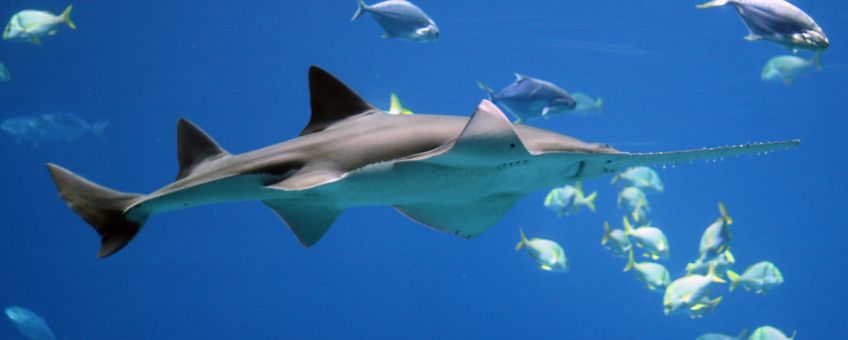
Conservation call on sawfish nursery
Murdoch UniversityAssociate Professor David Morgan and a team from the Centre for Fish and Fisheries Research used acoustic telemetry to record the movements of a number of juvenile Green Sawfish (Pristis zijsron) near the mouth of the Ashburton River and in adjacent tidal mangrove creeks near Onslow in the Pilbara.
The species, which can reach a length of up to 7.3 metres, is found in the tropical waters of the Indo-West Pacific oceans, with nurseries occurring in relatively shallow coastal waters or estuaries. But the fish is believed to have suffered a major recent decline due to factors which are common issues for the five different species in the sawfish family, including a loss of nursery habitats, barriers to migration and the susceptibility of their distinctive rostrum to entanglement in fishing nets.
The key nursery habitat in Australia
 “Identifying and then protecting nursery habitats is crucial for conservation efforts, and the southern Pilbara currently represents the key nursery habitat in Australia for this species,” Professor Morgan said. “An understanding of how the young sawfish then move within these habitats is also important for sustainably managing their populations along developing and developed coastlines like that of the Pilbara.”
“Identifying and then protecting nursery habitats is crucial for conservation efforts, and the southern Pilbara currently represents the key nursery habitat in Australia for this species,” Professor Morgan said. “An understanding of how the young sawfish then move within these habitats is also important for sustainably managing their populations along developing and developed coastlines like that of the Pilbara.”
Professor Morgan said recent studies of the related Freshwater Sawfish in the Kimberley had found that the very young remain in shallow waters and move into deeper waters of the same habitat in their second year, presumably to avoid predators, strandings and for feeding. “We believe green sawfish use habitat in a similar, very restricted way. As such, even small management interventions such as simple campaigns educating the public about the conservation status of sawfishes which urge them to avoid fishing in these areas or collecting their rostrum as trophies, could help with their protection.”
“But it is concerning that in a few short visits to the area in 2011 and 2012 by our research team, we witnessed evidence of trophy collecting and illegal gill netting.”
Acoustic transmitters
Professor Morgan and his team tagged 37 juvenile green sawfish with acoustic transmitters for the study during April and October 2011. Their movements were tracked by receivers placed on moorings throughout the study area for up to 500 days. It was found that the youngest sawfish stayed close to the river mouth, with movement increasing with growth. Larger sawfish moved between the river mouth or creeks and nearshore coastal habitats depending on the tide. Professor Morgan said more research was urgently required to understand the distribution and habitat use of Green Sawfish along the Western Australian coastline.
“There is a high likelihood that other river mouths and estuaries are providing important nurseries for Green Sawfish,” he said. “Based on the global importance of the region for sawfish conservation, it would be best to gather this information to help plan sawfish management before human pressures escalate in these once-remote places.”
The research was published in the scientific journal Endangered Species Research.
Text: Murdoch University
Photos: Forrest Samuels; Don Ramey Logan
